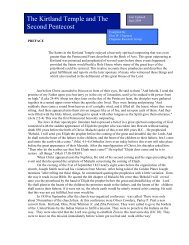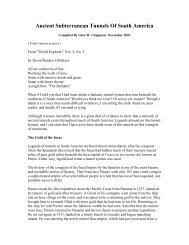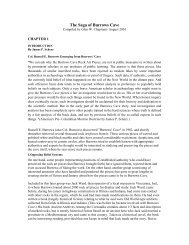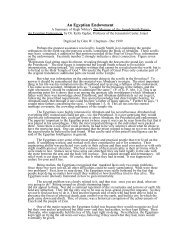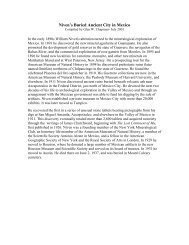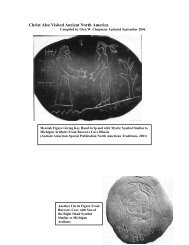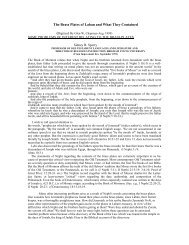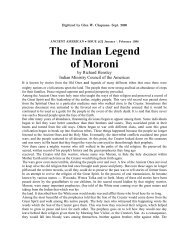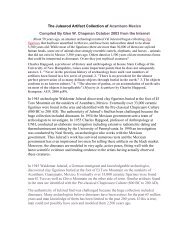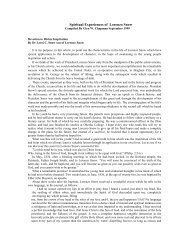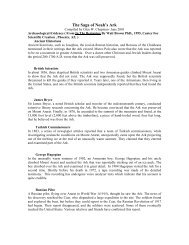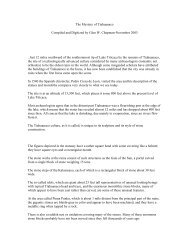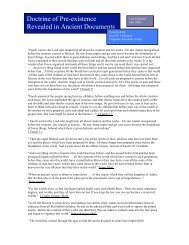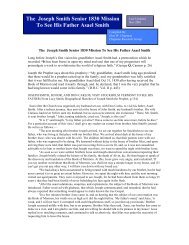Book of Mormon Evidences From Ancient Aztec and Mayan Writings
Book of Mormon Evidences From Ancient Aztec and Mayan Writings
Book of Mormon Evidences From Ancient Aztec and Mayan Writings
Create successful ePaper yourself
Turn your PDF publications into a flip-book with our unique Google optimized e-Paper software.
They say that shortly after he went to Peru—wearing a loose mantle over hisshoulders, either fastened with a clasp at the breast, or knotted at the corners, whence it may beinferred that this man was some apostle whose name they do not know. * * * They call himQuetzalcoatl, which signifies the serpent birdman, account <strong>of</strong> the swiftness with which he passedfrom a distant country to theirs.”Ant, <strong>of</strong> Mex., VoL 6, p. 51.Kingsbourough's Conclusion"It is unnecessary to attempt in this place to trace out. any further scriptural analogies inthe traditions <strong>and</strong> mythology <strong>of</strong> the New World, since the coincidences which have been alreadymentioned are sufficiently strong to warrant the conclusion that the Indians at a period longantecedent to the arrival <strong>of</strong> the Spaniards in America, were acquainted with a portion at least <strong>of</strong>the Old Testament, although time, superstition <strong>and</strong> above all, such an imperfect mode <strong>of</strong> transmittingto posterity the memory <strong>of</strong> the past events as that <strong>of</strong> painting, had greatly corrupted theirancient traditions.We shall close these observations with the following curious extract fromYorquemada, from which it might appear that even the New Testament had been known to theIndians: “Another ecclesiastic, named Brother Diego de Mercado, a grave father, who had beendefinitor <strong>of</strong> this province <strong>of</strong> the Holy Ghost, <strong>and</strong> one <strong>of</strong> the most exemplary men <strong>and</strong> greatestdoers <strong>of</strong> penance <strong>of</strong> his time, relates <strong>and</strong> authenticates this relation with his signature, that someyears ago, conversing with an old Indian <strong>of</strong> the Otomies, above seventy years old, respectingmatters concerning our faith, the Indian told him that they in ancient times had been inpossession <strong>of</strong> a book which was h<strong>and</strong>ed down successively from father to son, in the person <strong>of</strong> theeldest, who ‘vas dedicated to the safe custody <strong>of</strong> it <strong>and</strong> to instruct others in its doctrines. Thesedoctrines were written in two columns <strong>and</strong> between column <strong>and</strong> column Christ was paintedcrucified, with a countenance as <strong>of</strong> anger. They accordingly said that God was <strong>of</strong>fended; <strong>and</strong> out<strong>of</strong> reverence did not turn over the leaves with their h<strong>and</strong>s, but with a small bar, which they madefor that purpose, which they kept along with the book.On this ecclesiastic questioning the Indian <strong>of</strong> the contents <strong>of</strong> that book, <strong>and</strong> its doctrines, hewas unable to give him farther information, but simply replied that if the book had not been losthe would have seen that the doctrines which he taught <strong>and</strong> preached to them, <strong>and</strong> those which thebook contained, were the same; that the book had rotted in the earth, where the persons who keptit had buried it on the arrival <strong>of</strong> the Spaniards"Torquemada says that a friar named Diego de Mercado, had a conversation with an OtomiIndian over 70 years old, concerning the Indian's faith. The Indian told him that long ago, theOtomis were in possession <strong>of</strong> a book, that had been h<strong>and</strong>ed down from father to son & guardedby persons <strong>of</strong> importance, whose duty it was to explain the book. Each page <strong>of</strong> the book had 2columns, & between these columns were paintings which represented Christ crucified. Theyturned the pages with a tiny stick kept along with the book for that purpose. The friar asked theIndian what the book contained. The old Indian could not give details, but suggest that it'steachings would be like, if not the same as the friar's. The problem was that they did not have thebook to compare both faiths with, because the book had been hidden away in the ground by it'sguardians who had buried it at the arrival <strong>of</strong> the Spaniards. Father de Mercado went on to say thatfurther discoveries had been made concerning the natives' dogmatic theology, namely those insome <strong>of</strong> the provinces <strong>of</strong> the "New Spain" area. Among the Totonacs, the people expected theadvent <strong>of</strong> the Son <strong>of</strong> the great God into this world. He had to come in order to "renew all things."This was not a spiritual renovation, but an earthly material improvement. (2 Ne.3:3-25; &: IndianLegends, by James W. Lesueur, 1928, pp.221-3, Antiquities <strong>of</strong> Mexico, Kingsborough, V.40,p.409.).



